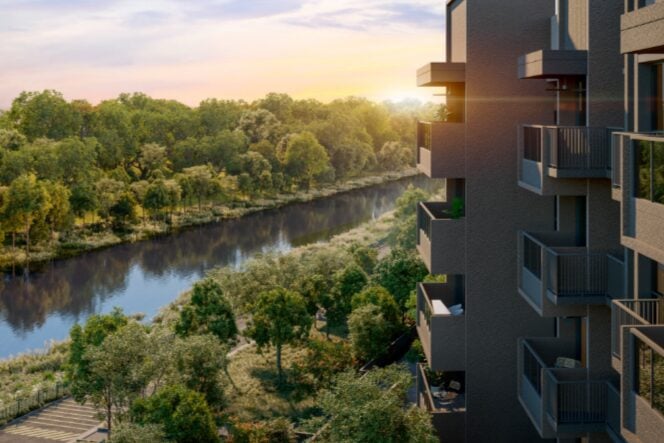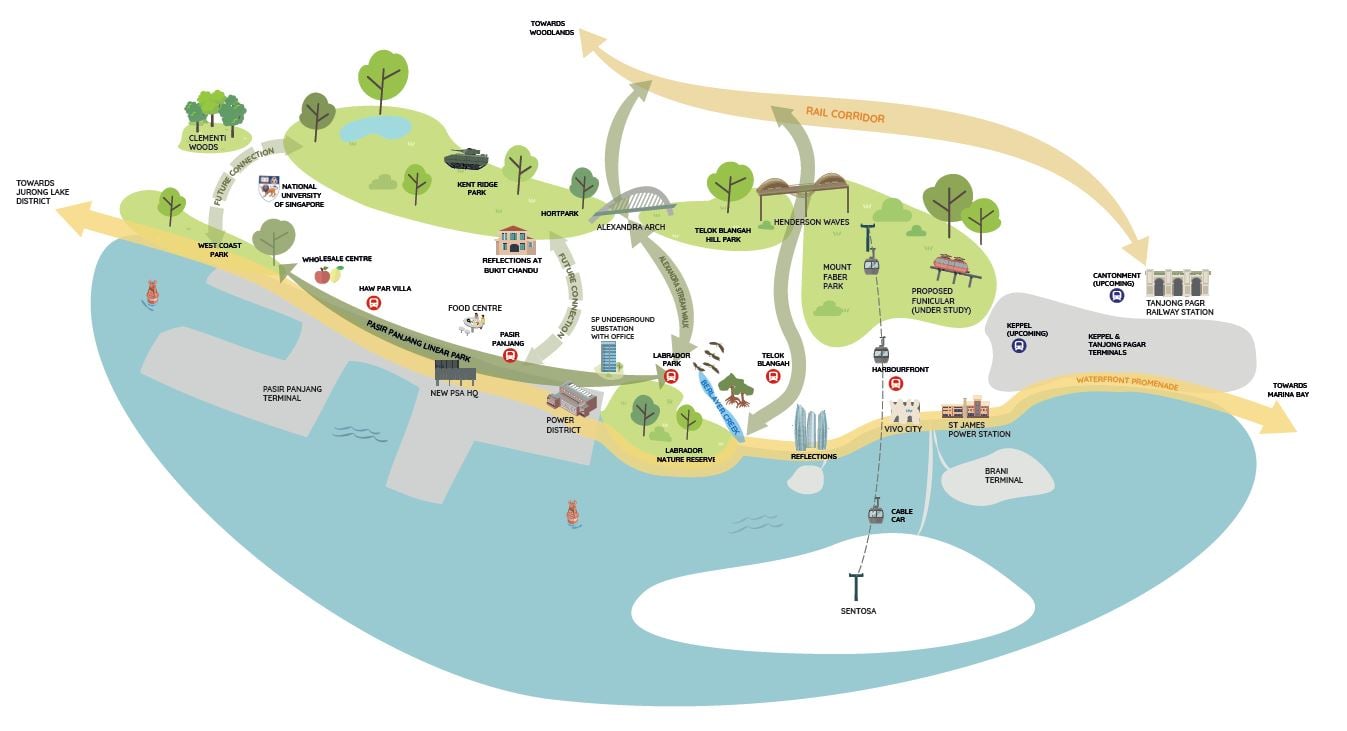If you’ve been keeping an eye on our property market, you’ll know that exciting changes are taking place across the island – from new residential projects to large-scale urban transformations. This week, Susan Ng from CNA and Felicia Tan from 99.co sat down with two guests to discuss what these changes mean – both for individual homeowners and for the country’s urban future.
Table of contents
- Faber Residence: A blend of nature, comfort, and connection
- The Greater Southern Waterfront: what to expect from its transformation?
Faber Residence: A blend of nature, comfort, and connection

One of the highlights of the discussion was Faber Residence, a new project that’s drawing attention for its lush, resort-style setting in the Ulu Pandan area. In their conversation with Martin Ng, Senior Associate Division Director at PropNex, Susan and Felicia explored how this development blends greenery, thoughtful design, and modern living.
A home surrounded by greenery
Faber Residence will feature around 400 units, ranging from 2- to 5-bedroom layouts. Located within 1 kilometre of Nan Hua Primary School, it’s bound to attract families, especially parents hoping to secure a spot for their children in the well-known school.
According to Martin, the development appeals most to nature lovers. “Greenery is becoming less common in Singapore,” he explained, noting that the site’s proximity to the Ulu Pandan Park Connector adds to its charm. Its closeness to the Jurong Lake District, Singapore’s upcoming second CBD, also makes it attractive to those looking for long-term growth potential.
When it comes to buyer demographics, Martin shared that most interested parties are Singaporeans and Permanent Residents, suggesting a predominantly local community once the project is completed.
Designed to blend with its surroundings
Set on a generous 277,000 square feet of land, Faber Residence sits within a landed housing enclave, surrounded by low-rise semi-detached and detached homes. Sitting on a plot ratio of 1.5, the project is being built up to five storeys, where blocks are spaced 20 to 29 metres apart providing a vast sense of space that blends naturally into the neighbourhood’s skyline.
Martin described the design as having a resort-like feel, adding that the architecture was planned to complement both the natural greenery and the landed environment. “You’ll find birds and small mammals around, which makes it great for those who enjoy birdwatching,” he said.
Sustainability at the core
Sustainability is another cornerstone of this project. The developer has incorporated solar panels and sound-minimising design features to enhance everyday living. “The idea is to make the environment more energy-efficient,” Martin explained. The abundance of greenery also helps lower surrounding temperatures, allowing residents to rely less on air conditioning and reduce their utility costs over time.
With over 140 plant species included in the landscaping, residents can look forward to a serene, cooling atmosphere that supports both comfort and eco-friendliness.
Amenities that bring nature closer to home
Beyond its green design, Faber Residence offers an impressive range of 18 landscaped courtyards, each with a different theme. Some feature water elements, while others are designed for relaxation and community gatherings. The centrepiece is a 50-metre lap pool accompanied by a jacuzzi area that adds a touch of resort luxury.
Martin pointed out that residents can enjoy the Ulu Pandan Park Connector directly from the development, giving them quick access to the Clementi Nature Corridor. “You can easily take a walk from home without needing to travel elsewhere for greenery,” he said.
Read our review on Faber Residence here: Faber Residence: Low-rise riverfront condo launches from S$1,995 psf
Location and accessibility
The residence’s location also balances tranquillity with convenience. While it’s right beside the AYE expressway, developers have taken several measures to manage noise levels. The first block sits about 25 metres away from the AYE, with thick vegetation buffers in front. Units near the expressway feature glass panelling instead of open railings, which helps minimise sound.
Additionally, none of the units directly face the highway, and since the development is limited to five storeys, residents are less likely to experience significant noise disruptions.
The Greater Southern Waterfront: what to expect from its transformation?

The second part of the discussion turned to the Greater Southern Waterfront (GSW) – one of Singapore’s most ambitious long-term redevelopment projects. To shed light on what’s ahead, Susan and Felicia spoke with Professor Sing Tien Foo, Provost’s Chair Professor at NUS Business School’s Department of Real Estate.
A vision for the next 50 years
Stretching 30 kilometres from Gardens by the Bay to Pasir Panjang, the GSW represents Singapore’s next frontier for growth. As Professor Sing shared, this area holds deep historical roots – it was where the British first arrived and developed Singapore’s earliest port communities. Over time, that expansion shaped today’s Central Business District.
Looking ahead, the GSW’s transformation is expected to reshape how Singaporeans live, work, and play by the water. “This will have a big impact over the next 30 to 50 years,” said Professor Sing. “There’s a lot of potential in this stretch of land.”
Building a city in nature
The development aligns closely with Singapore’s ‘City in Nature’ vision, part of the Singapore Green Plan 2030. The goal is to move towards net-zero emissions by 2050, while weaving greenery into urban design.
Professor Sing noted that this plan builds on Singapore’s long-standing “Garden City” concept. “We’re learning not just to plant trees but to live with nature,” he said. “That means preserving existing biodiversity and designing around it rather than clearing it away.”
From ports to homes and workspaces
The relocation of the Keppel and Tanjong Pagar container ports is already underway, with operations expected to end by 2027–2028. The Pasir Panjang terminal will follow in the 2030s or 2040s. Once vacated, these sites will free up prime land close to the city, allowing the CBD to extend seamlessly from Tanjong Pagar to Marina Downtown.
This transformation revives what was once Singapore’s “Wall Street” during the 1970s and 1980s – reimagined for a modern economy that includes tech, innovation, and green industries.
Inclusive living at the Waterfront
One of the key highlights is the upcoming Berlayar Estate, located on the former Keppel site. Planned to feature 7,000 public and 3,000 private housing units, it represents a rare example of mixed-income living along Singapore’s waterfront.
Professor Sing emphasised how unique this is globally. “It’s very rare to find public housing in prime, waterfront areas,” he said. “But Singapore is making it possible – this adds diversity, inclusivity, and a stronger community mix.”
Read more: Berlayar estate to launch with 7,000 new HDB flats at former Keppel Club site
Sustainable design and heritage preservation
As Singapore moves forward, Professor Sing shared that it would be ideal for future developments to focus on preserving forests, mangroves, and marine life instead of clearing them. He suggested that environmental experts should be consulted to maintain a balance between urban growth and ecological conservation.
He also noted that heritage buildings such as the Pasir Panjang Power Station and the former Pasir Panjang English Teachers’ School could be conserved, allowing the area to retain its historical character even as new projects take shape.
Economic opportunities and connectivity
The GSW will also serve as a hub for new businesses and commercial activity, complementing existing districts. With projects like Mapletree Business City already attracting major firms such as Google, more high-tech and innovation-driven companies are expected to follow.
Enhanced connectivity through the Circle Line and Thomson-East Coast Line will make the area easily accessible from the CBD and western regions, supporting Singapore’s broader decentralisation strategy.
A coastal lifestyle for the future
Ultimately, the GSW promises to redefine waterfront living. With the Sentosa-Brani Masterplan in the works, the area could evolve into a hub for wellness, tourism, and recreation, drawing both locals and international visitors. “People may soon come not just for F1, but for everything the southern coast offers – from leisure to healthcare,” said Professor Sing.
The post [Open House] How Faber Residence and the Greater Southern Waterfront reflect Singapore’s next phase of growth appeared first on .

